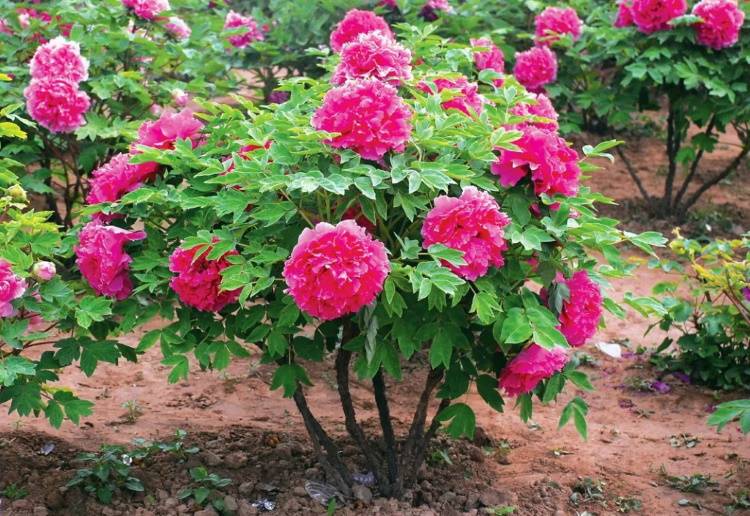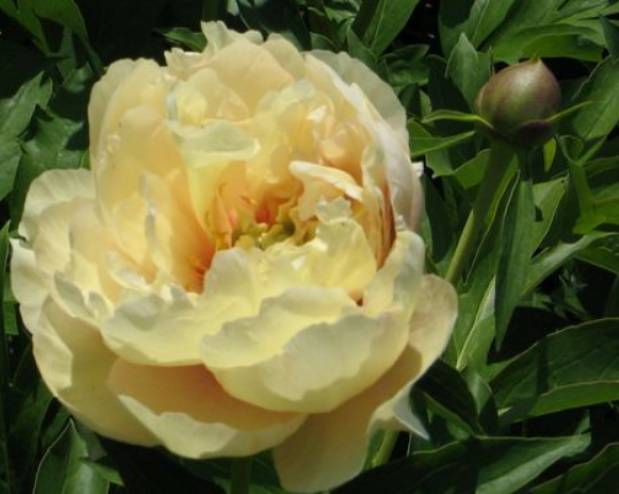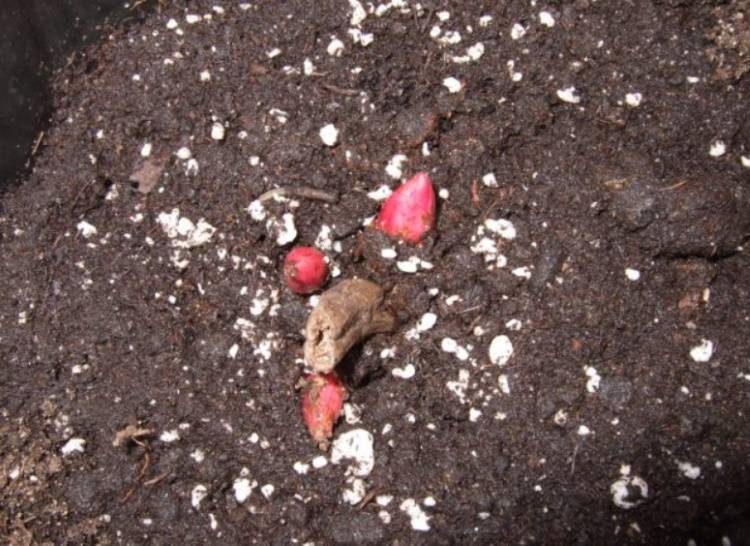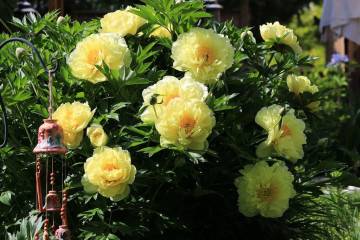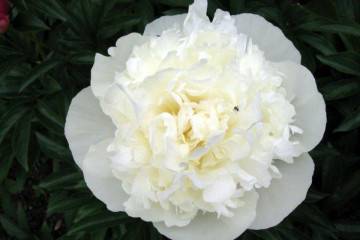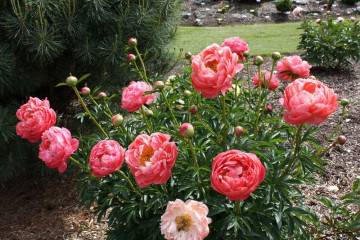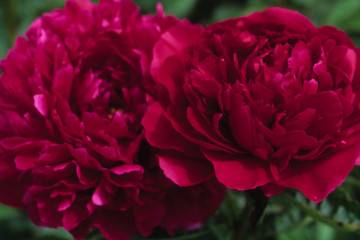Peony Canary Brilliants (Paeonia Canary Brilliants)
Content:
Europeans have been growing peonies as a culture that decorates parks and gardens for only 2-3 centuries, the Chinese for several thousand years. Until recently, mankind knew only two species of perennial plants attributed to the genus Paeоnia - herbaceous, which once adorned only the palaces of emperors and kings, and tree and shrub peonies with large flowers and buds. In herbaceous peonies, leaves and stems die off for the winter, in tree peonies only leaves fall off.
History of creation
Among the herbaceous peonies, there were always many beautiful flowers, but there were no plants with gold-colored petals, but some shrubs bloomed with yellow inflorescences. The desire of the Japanese scientist Toichi Itoh to have a sun-colored flower in his garden made him start crossing herbaceous and tree-like peonies. But only after the death of the breeder were hybrids with yellow inflorescences obtained. In 1974 they were registered by the American Peony Society.
Numerous varieties of hybrids obtained by interspecific crossing began to be given the name Ito-peonies. They are characterized by inheritance with a simultaneous improvement in the characteristics inherent in both parents:
- abundant and long flowering;
- powerful grassy stems that do not require a garter;
- inflorescences up to 20 cm in diameter;
- increased frost resistance and drought resistance.
Description of ITO-peony Canary Brilliants (Paeonia Itoh Canary Brilliants)
Peony Canary Brilliants belongs to a group of elite, prestigious plants from the genus Paeоnia, famous for the unique colors of the petals. The hybrid was created in 1999 by the American hybridizer R. Anderson. In 2010, the peony Itoh Canary Brilliants received the Award of Landscape Merit from the American Peony Society.
On each stem of the peony Itoh Canary Brilliants, up to 4 buds are tied. In light partial shade, semi-double inflorescences of the Canary Brilliant peony during the flowering period change their color from pinkish, delicate peach to yellow shades. The bases of the petals, wavy at the edges, are colored reddish.
The flowering of the bush lasts about 3 weeks. The flowers have stamens and pistils, but there is no pollen, so no seeds are formed after the flower withers. In a bouquet placed in a vase of water, the cut branches of the peony do not lose their petals for 10 days. The flowers smell good.
The bushes have a spreading, raised shape, dense branching, dense foliage, strong flower stalks. The plant as a whole looks magnificent and massive. Flower stems up to 80 cm high do not lean to the ground even during the period of massive bud opening.
The size and appearance of the leaf plates of the peony Kenery Brillint received from a tree ancestor. Leaves during the growing season and flowering are painted in a rich dark green color, in August their color changes and becomes bronze-burgundy.
Growing a flower
In one place, the Keneri Diamond peony can grow for several decades.At the age of 4-5 years, the bush can be divided into root cuttings with 3-4 growth buds, and transplanted to new places. This method of propagation of the hybrid will retain its hereditary characteristics.
The division of the rhizomes of the bush or its complete transplantation is carried out before the beginning of the growing season and after the end of flowering. The best option for gardeners is the autumn planting of the Itoh hybrid, carried out on warm days from mid-September.
The site for transplanting the Canary Brilliant hybrid is prepared several months before transplanting. Preparatory work provides that the land needs to be freed from weeds, dug up, treated with fungicides to prevent fungal diseases, fertilize and deacidify if necessary, since flowers need soil with neutral acidity. Sand, rotted humus, compost are added to clay soils.
Plants are planted at a distance of at least 1 m from each other. A planting hole up to 50 cm deep is dug a day before planting the cuttings. Drainage and a layer of soil substrate are laid at the bottom of the pit. Then, up to 5 liters of water is poured into the pit.
The next day they land. The delenka is laid at the bottom of the pit at an angle of 45 °, sprinkled with dry earth. Growth buds are buried into the ground by no more than 1.5-2 cm. After that, the bush is watered with settled water at room temperature. The soil in the hole around the cutting is compacted and a layer of dry substrate is poured again.
Plant care
If the planting is carried out in the fall, then before the onset of cold weather, young bushes are covered with a layer of leaves and straw. Adult plants do not always need a pre-winter shelter; many types of ITO hybrids endure frosts down to -20 ° C in snowy winters.
In the spring, if necessary (2-3 years after planting the bush), nitrogen-potash fertilizers are applied to the root zone of the Canary-hybrid Canari diamond. In autumn, the plants are fed with complex phosphorus-potassium fertilizers, which are supplemented with trace elements.
Adult flowers are watered after the onset of heat. Up to 2 buckets of water are poured under the bush every week. Young hybrids need watering much more often, but in smaller volumes. The root zone of peonies is loosened after the appearance of a dried crust, at the same time weeds are removed.
ITO bushes rarely get sick, but they can still sometimes suffer from root rot, powdery mildew and pests. For the prevention of fungal diseases in the spring in the evening, the branches of flowers are treated with solutions of fungicidal biological products - phytosporin, trichodermin, alirin, gamair. These same drugs are used to fight disease. To exterminate insects, insecticide solutions of Actara, Actellik, Decis, Thunder-2, Confidor are used.
Blooming Paeonia Itoh Canary Brilliants
Diamonds peonies bloom in mid-spring and can last until early June. Buds are formed on the central and lateral shoots, they bloom alternately. Inflorescences that have dropped petals must be periodically trimmed so as not to spoil the appearance of the peony. The bushes are watered periodically.
If the plant sets few buds, it means that it either grows in the shade, or the soil in the root zone of the bushes is depleted. Transplanting to a new location or applying fertilizers in the spring and autumn will help correct the situation.
Preparing for winter
Pre-winter pruning of the stems of ITO-hybrids is carried out after the plants begin to wilt, but before the onset of constant cold rainy days. After pruning, hemp 2-3 cm high should remain on the soil surface.
Winter-hardy ITO hybrids can suffer from frost in a snowless winter, therefore, it is necessary to decide on the insulation of peony bushes based on real weather conditions. Agrofibre folded in several layers, spruce branches, rotted sawdust, a mixture of sand and peat are used as mulch.
People who grow hybrid peonies Itoh Canary Brilliants can be considered the real lucky ones. Indeed, in their gardens on flower beds in early spring, magnificent flowers bloom, the sight of which causes delight and admiration.
